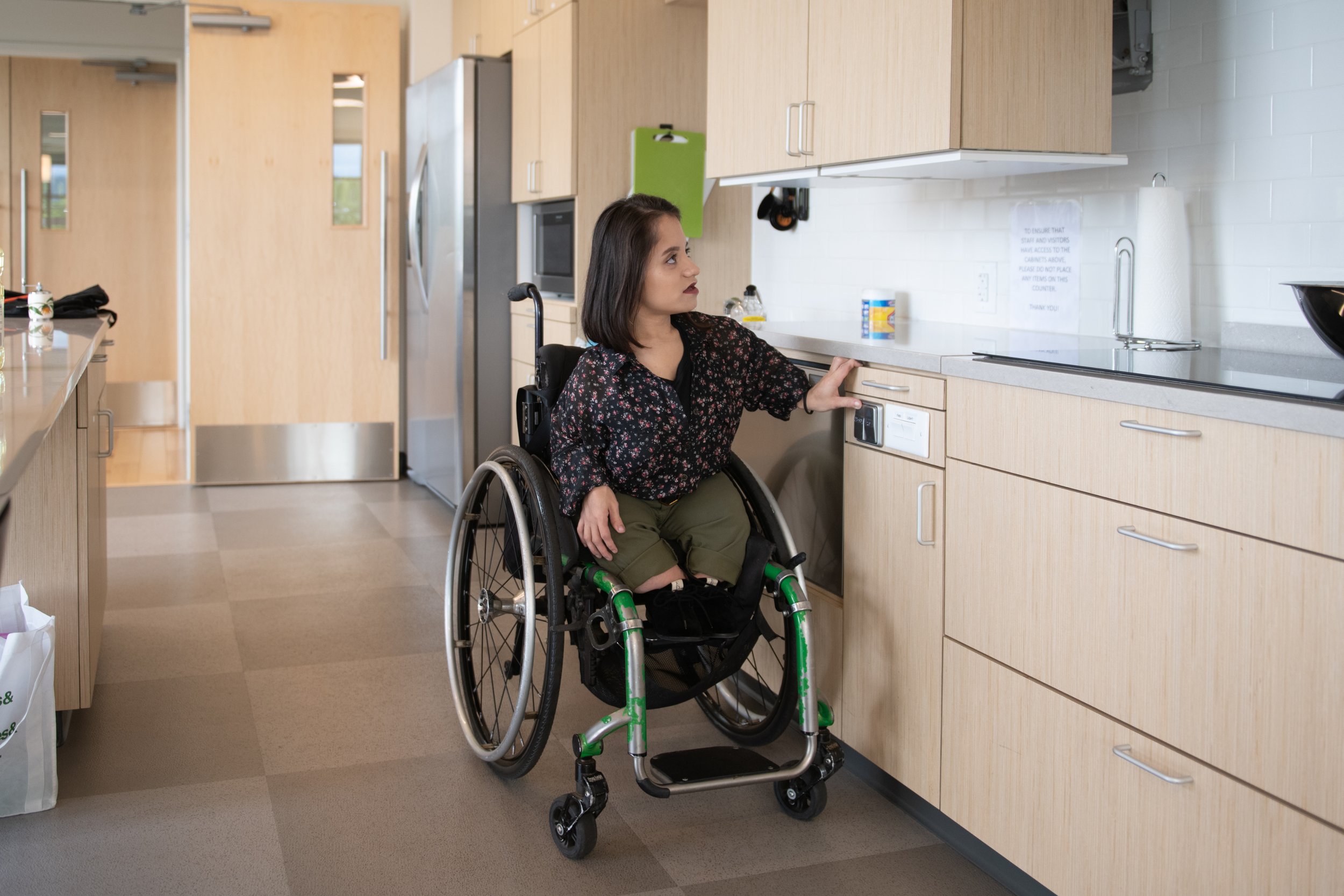Easy and Effective Solutions for Kitchen Accessibility
Image description: A South Asian person sits in her wheelchair and presses a button to lower the height-adjustable shelves in an accessible kitchen.
Image source: Disabled and Here.
Most people, regardless of cooking affinity or skill, use their kitchen at least once a day. You might be making a sandwich, microwaving leftovers, or cooking a full meal from scratch. However, disabled and neurodivergent people may find themselves navigating challenges every time they need to prepare themselves or their family’s a meal due to an inaccessible kitchen layout and organization.
Creating an inclusive, accessible kitchen—specific to the needs of everyone in the home—improves safety, independence, creativity, nutritional intake, engagement, and confidence. People who own their homes (and have the financial ability) may be able to make substantial upgrades to kitchen appliances and overall layout, but kitchen accessibility does not have to be a major renovation. There are no cost and low-to-moderate cost steps that can have a high value in creating a safer, more accessible kitchen for your and your family’s needs.
Here are some of our no and low cost ideas for you can implement today that can improve your kitchen accessibility:
Remove Unnecessary Clutter
Simplify your space by clearing the floor, refrigerator, counters, and cabinets of clutter. Eliminate tripping hazards such as runners and rugs, especially if you have a young child or someone using a walker, wheelchair, or cane utilizing the kitchen.
Take Inventory
Review your cookware, small kitchen appliances, and eating utensils. Discard broken items and duplicates. While having twelve spoons for a family of three or four is great, multiple blenders and air fryers take up precious cabinet space. Keep only the essentials for a more organized kitchen.
Add Labels
Not knowing where an item is in the kitchen can be a frustrating experience that also uses physical and cognitive energy. Label drawers with clear fonts and contrasting colors for easy identification, or use a label maker. Alternatively, take pictures of drawer contents and laminate them for a realistic view, accommodating those who don’t read or who need more visual reminders.
Relocate Frequently Used Items
Consider storing frequently used items in lower cabinets and drawers or on the counter for easier accessibility compared to upper cabinets. Keep things you use frequently in the front and store things you only use occasionally in the back. Consider a rotating tower for condiments and spices or cups and utensils.
Add Lighting
Enhance task lighting and safety with under-cabinet lighting. Some options come with motion detection features for added orientation and safety, which is especially helpful for someone who often forgets to turn on (and off!) the lights.
Reduce Your Risk for Injuries
Invest in oven mitts and utensils that are long in length, anti-splatter guards, and anti-boil-over cookware to protect yourself from burns. Maintain clean and dry slip-resistant floors to reduce the risk of injury, especially for children. It is also wise to keep a first aid kit in the kitchen.
Utilize Smart Technology
Incorporate voice-activated technology for tasks like asking for recipes, setting timers, or maintaining a shopping list. “[Insert digital assistant name here], add milk to my shopping list".”
Purchase Non-Slip Items
Opt for suction-bottom mixing bowls, serving trays, and plates to prevent spills and reduce the risk of falls and injuries. Use non-slip mats (we use Silpats we already have on hand but we also like Dycem for maximum stability) to stabilize cutting boards. Use them under mixing bowls for one-handed mixing.
Organize and Keep Items Within Reach
Convert under-cabinet shelving to pull-out drawers and install organizers for spices, plates, or utensils. Streamline access by organizing drawers, cabinets, and pantries effectively.
Add Grab Bars
Improve participation, safety, and accessibility with grab bars strategically installed near countertops and above lower cabinet hinges. Professional installation ensures adequate weight support.
Incorporating these accessibility features not only enhances the enjoyment and efficiency of time spent in the kitchen but also ensures a heightened level of safety. It's important to note, however, that these suggestions may not universally apply to everyone. Given the unique access needs of each person, kitchen modifications should be tailored to best support their individual abilities and preferences.
If you are thinking about modifying your kitchen to make it more accessible, you may consider reaching out to a trained professional, like an occupational therapist. Occupational therapists are trained to holistically support an individual in modifying their environment for maximum participation, safety, and enjoyment. If you are interested in working with an occupational therapist for this purpose, Culikid may be able to help! Please reach out to info@culikid.org to see how we can help you.
Check out our list of adaptive kitchen tools for more ideas about accessibility in the kitchen.


